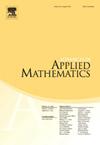Dynamics of pop-tsack torsing
IF 1.3
3区 数学
Q3 MATHEMATICS, APPLIED
引用次数: 0
Abstract
For a finite irreducible Coxeter group with a fixed Coxeter element c and set of reflections T, Defant and Williams define a pop-tsack torsing operation given by where is the join of all reflections lying below w in the absolute order in the non-crossing partition lattice . This is a “dual” notion of the pop-stack sorting operator ; was introduced by Defant as a way to generalize the pop-stack sorting operator on to general Coxeter groups. Define the forward orbit of an element to be . Defant and Williams established the length of the longest possible forward orbits for Coxeter groups of coincidental types and Type D in terms of the corresponding Coxeter number of the group. In their paper, they also proposed multiple conjectures about enumerating elements with near maximal orbit length. We resolve all the conjectures that they have put forth about enumeration, and in the process we give complete classifications of these elements of Coxeter groups of types A, B and D with near maximal orbit lengths.
弹袋扭转动力学
对于具有固定Coxeter元素c和反射集T的有限不可约Coxeter群(W,S), Defant和Williams定义了一个pop-tsack扭转运算PopT:W→W,由PopT(W)= W·π(W)−1给出,其中π(W)=±T≤Tw, T∈TNC(W, c) T是在非交叉分割格NC(W, c)中位于W以下的所有反射的绝对序连接。这是pop-stack排序操作符PopS的“双重”概念;pop是由Defant引入的,作为将Sn上的pop-stack排序算子推广到一般Coxeter群的一种方法。定义元素w∈w的正向轨道为OPopT(w)={w,PopT(w),PopT2(w),…}。Defant和Williams根据群对应的Coxeter数建立了巧合型和D型Coxeter群的最长可能正向轨道的长度maxw∈W∈|OPopT(W)|。在他们的论文中,他们还提出了关于列举轨道长度接近最大的元素的多个猜想。我们解决了他们提出的关于枚举的所有猜想,并在此过程中给出了A、B和D型Coxeter群中轨道长度接近最大值的元素的完整分类。
本文章由计算机程序翻译,如有差异,请以英文原文为准。
求助全文
约1分钟内获得全文
求助全文
来源期刊

Advances in Applied Mathematics
数学-应用数学
CiteScore
2.00
自引率
9.10%
发文量
88
审稿时长
85 days
期刊介绍:
Interdisciplinary in its coverage, Advances in Applied Mathematics is dedicated to the publication of original and survey articles on rigorous methods and results in applied mathematics. The journal features articles on discrete mathematics, discrete probability theory, theoretical statistics, mathematical biology and bioinformatics, applied commutative algebra and algebraic geometry, convexity theory, experimental mathematics, theoretical computer science, and other areas.
Emphasizing papers that represent a substantial mathematical advance in their field, the journal is an excellent source of current information for mathematicians, computer scientists, applied mathematicians, physicists, statisticians, and biologists. Over the past ten years, Advances in Applied Mathematics has published research papers written by many of the foremost mathematicians of our time.
 求助内容:
求助内容: 应助结果提醒方式:
应助结果提醒方式:


